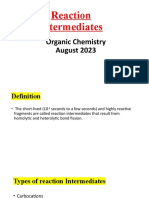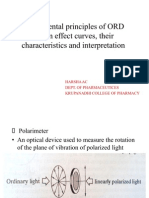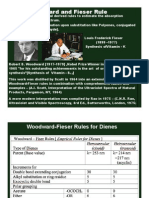Stereoselective & Stereospecific Reactions
Stereoselective & Stereospecific Reactions
Uploaded by
Raja RajaCopyright:
Available Formats
Stereoselective & Stereospecific Reactions
Stereoselective & Stereospecific Reactions
Uploaded by
Raja RajaOriginal Title
Copyright
Available Formats
Share this document
Did you find this document useful?
Is this content inappropriate?
Copyright:
Available Formats
Stereoselective & Stereospecific Reactions
Stereoselective & Stereospecific Reactions
Uploaded by
Raja RajaCopyright:
Available Formats
STEREOSELECTIVE & STEREOSPECIFIC REACTIONS
Stereochemistry plays an important role in chemical reactions. There are many reactions of chiral
and achiral molecules and the formation of product in such case is controlled by stereochemical
consideration such as regioselective, Stereoselective and stereospecific reactions.
Stereoselective reactions: Stereoselectivity is the property of a chemical reaction that yields an
unequal mixture of isomers from a single reactant. It may be partial, where the formation of one
isomer is favoured over the other, or it may be total where only one isomer is formed.
Stereospecific reactions: Stereospecificty is the property of a reaction mechanism that yields
different isomeric products from different isomeric reactants, or which operates on only one (or a
subset) of the isomers. That is, a given isomer leads to one product while another isomer leads to
the opposite product.
Few important points:
(i) All stereospecific reactions are necessarily stereoselective, but the vice-versa is not true.
(ii) A stereospecific mechanism specifies the stereo-chemical outcome of a given reactant, whereas
a stereoselective reaction selects products from those made available by the same, non-specific
mechanism acting on a given reactant. A consequence of these definitions is that if a reaction is
carried out on a compound that has no stereosisomers, it cannot be stereospecific, but
stereoselective.
(iii) Stereospecificity is the property of a reaction mechanism, whereas stereoselectivity is the
property of reactant.
BP 401T (Pharm. Organic Chemistry-III), by Prof. Asif Husain Page 1
BP 401T (Pharm. Organic Chemistry-III), by Prof. Asif Husain Page 2
BP 401T (Pharm. Organic Chemistry-III), by Prof. Asif Husain Page 3
You might also like
- Stereoselective and Stereospecific ReactionsNo ratings yetStereoselective and Stereospecific Reactions20 pages
- Advanced Organic Chemistry - I (MPC 102T) Unit-I: Basic Aspects of Organic Chemistry Types of Reaction Mechanisms and Methods of Determining ThemNo ratings yetAdvanced Organic Chemistry - I (MPC 102T) Unit-I: Basic Aspects of Organic Chemistry Types of Reaction Mechanisms and Methods of Determining Them29 pages
- Oxidation - (Pharmaceutical Process Chemistry)No ratings yetOxidation - (Pharmaceutical Process Chemistry)34 pages
- Asymmetric Synthesis, Partial and Absolute With Examples100% (1)Asymmetric Synthesis, Partial and Absolute With Examples4 pages
- Aliphatic Electrophilic Substitution Reactions88% (74)Aliphatic Electrophilic Substitution Reactions16 pages
- Applications of Thermo Gravimetric Analysis (Tga)No ratings yetApplications of Thermo Gravimetric Analysis (Tga)13 pages
- Basic Principles of Photochemical Reactions: - The First Law of Photochemistry, The Grotthuss-Draper Law, States ThatNo ratings yetBasic Principles of Photochemical Reactions: - The First Law of Photochemistry, The Grotthuss-Draper Law, States That40 pages
- Chemistry of Peptides: A Coupling Reaction in Peptide SynthesisNo ratings yetChemistry of Peptides: A Coupling Reaction in Peptide Synthesis14 pages
- UNIT I: Benzene and Its Derivatives: Analytical, Synthetic and Other Evidences in The Derivation of Structure of Benzene100% (1)UNIT I: Benzene and Its Derivatives: Analytical, Synthetic and Other Evidences in The Derivation of Structure of Benzene17 pages
- Advanced Organic Chemistry-I (MPC 102T) Unit-I: Rearrangement Reaction100% (1)Advanced Organic Chemistry-I (MPC 102T) Unit-I: Rearrangement Reaction5 pages
- Preparation of 2,4,6tribromoaniline: PrincipleNo ratings yetPreparation of 2,4,6tribromoaniline: Principle7 pages
- Stereochemistry of SN Reactions PPT - Copy - Copy-1100% (2)Stereochemistry of SN Reactions PPT - Copy - Copy-128 pages
- Difference Between Fluorescence and PhosphorescenceNo ratings yetDifference Between Fluorescence and Phosphorescence9 pages
- Quantitative Structure Activity Relationship (Qsar)No ratings yetQuantitative Structure Activity Relationship (Qsar)20 pages
- NUCLEIC ACID METABOLISM COMPLETE NOTES (B.Pharm 2nd Sem) PDF100% (4)NUCLEIC ACID METABOLISM COMPLETE NOTES (B.Pharm 2nd Sem) PDF16 pages
- Neighbouring Group Participation PPT by Faiza Shah93% (14)Neighbouring Group Participation PPT by Faiza Shah17 pages
- A Textbook of Green Chemistry: Sankar P. Dey Nayim Sepay0% (3)A Textbook of Green Chemistry: Sankar P. Dey Nayim Sepay24 pages
- Presentation of Benzoic Acid From BenzamideNo ratings yetPresentation of Benzoic Acid From Benzamide18 pages
- UNIT 4 Pharmaceutical Analysis (Imprfect Pharmacy)No ratings yetUNIT 4 Pharmaceutical Analysis (Imprfect Pharmacy)13 pages
- Chemical Shift and Factors Affecting Chemical Shift: Sri Krishnadevaraya University College of PharmacyNo ratings yetChemical Shift and Factors Affecting Chemical Shift: Sri Krishnadevaraya University College of Pharmacy12 pages
- Synthetic Reagents and Applications: 1.aluminium Isopropoxide 2.N-Bromosuccinimide 3.diazomethaneNo ratings yetSynthetic Reagents and Applications: 1.aluminium Isopropoxide 2.N-Bromosuccinimide 3.diazomethane19 pages
- POC II PPT Unit I UNIT Benzene and Its DerivativesNo ratings yetPOC II PPT Unit I UNIT Benzene and Its Derivatives75 pages
- 28 June BP401T-Organic Chemistry IV Sem New SyllabusNo ratings yet28 June BP401T-Organic Chemistry IV Sem New Syllabus2 pages
- Surface and Interfacial Phenomena - SPANo ratings yetSurface and Interfacial Phenomena - SPA46 pages


































































